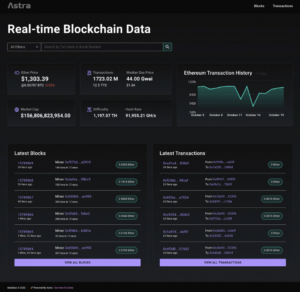DataStax Adds Blockchain to Cloud NoSQL for Web3 Development


(phive/Shutterstock)
DataStax gives users of its AstraDB cloud service free access to entire blockchains, starting with Ethereum, with the goal of making it easier for developers to create new Web3 applications.
DataStax noticed that some of their clients were trying to self-host Ethereum as part of their cryptocurrency analytics offerings. The company saw customers struggling to make it work, and that’s when they realized that DataStax was in a position to ease a lot of administrative overhead by building support for Ethereum directly into the platform.
Astra Block, as the new service is called, is a feature available to all users of AstraDB, the Cassandra database-as-a-service that DataStax originally launched back in 2019 (when it was called Constellation).
Astra Block currently hosts all of Ethereum, which is believed to be the largest blockchain, currently consisting of more than 1 TB of data, according to Alex Leventer, a Web3 developer at DataStax.
“It’s a heavy lift,” says Leventer Data mania. “It’s especially a heavy lift for the real-time aspect. Many of our users ran batch jobs, so the data is always out of date until you run the next job. So the real-time aspect is hard to do. All data modelling, all administration of the database – all that we take care of for the users.”
In addition to providing a copy of the blockchain, Astra Block exposes blockchain data via REST and GraphQL APIs or existing Cassandra drivers. The company has also built new indexes to gain faster access to frequently used data.

Astra Block includes the entire Etherum blockchain (image courtesy of DataStax)
The current state of blockchain development is not easy, which is why the overall goal of Astra Block is to simplify the lives of developers using the blockchain to build the next generation of Web3 applications, said Mike Hulme, vice president of marketing for the Santa Clara, California database- and blockchain company.
“You’re asking developers to work with hundreds of API connections” without Astra Block, he says. “You ask them to build their own indexers. You have to manage their own infrastructure. And it takes time to actually build the app, deliver the app, and do what’s valuable.”
A blockchain, of course, is a distributed ledger of transaction records stored in encrypted hashes. Blockchains are immutable and open, features that enable them to form a reliable chain.
Cryptocurrencies like Ethereum and Bitcoin use blockchains as the underlying technology that keeps everyone honest. The company plans to add support for additional blockchains in the future beyond Ethereum, including Bitcoin, Polygon, Solana and Binance, DataStax officials say.
While cryptocurrency is the most visible application of blockchain technology, it is not the only one. Many technologists have visions of using blockchains to displace institutions that today act as trusted intermediaries in various industries, from finance and real estate to healthcare and entertainment.
Blockchain is still in its infancy in terms of adoption, but the upside for the development of so-called Web3 applications is enormous, says Hulme.
“We want developers of all skill sets to have access to this,” he says. their own skills to this thing that has really changed the way applications are built. We think that makes it much more accessible, and we want to give it wider appeal to some industries that may not have been able to take advantage of blockchain today.”
One company currently developing Web3 applications on AstraDB is Blockscope. The Y Combinator company offers additional services on top of blockchains, including “no code” event listeners that monitor for transactions and events. When it detects an event of interest, it can trigger a webhook to perform several actions.
The future of blockchain has not yet been written, but DataStax wants to be part of the action, says Hulme.
“There’s a whole set of use cases coming out in different markets for blockchain. Crypto is the one I think a lot of people associate with, but we’re seeing a lot more interest around things like healthcare or real estate for different types of transactions and historical data,” he says. “Cassandra is built for speed scale. There’s nothing that compares to that. And so when you’re working with data sets that are so large that need to be accessed in real time, there’s no better combination of technologies than Cassandra and blockchain.”
Related Stuff:
DataStax powers real-time machine learning with Kaskada Buy
DataStax takes $115 million to help build real-time applications
DataStax taps Pulsar for streaming data platform

























